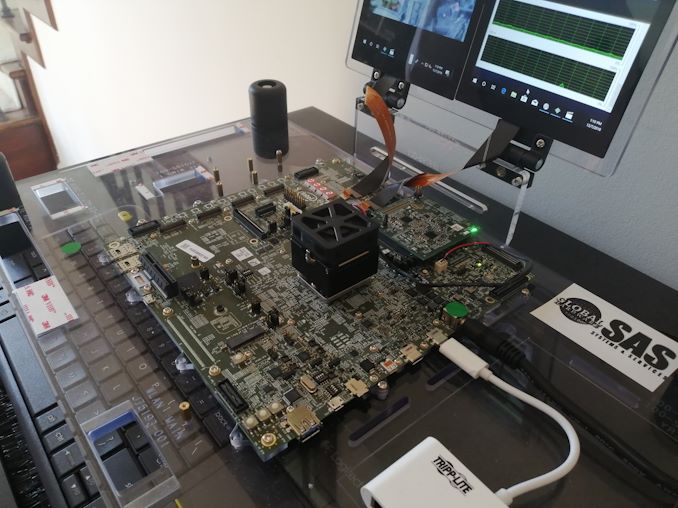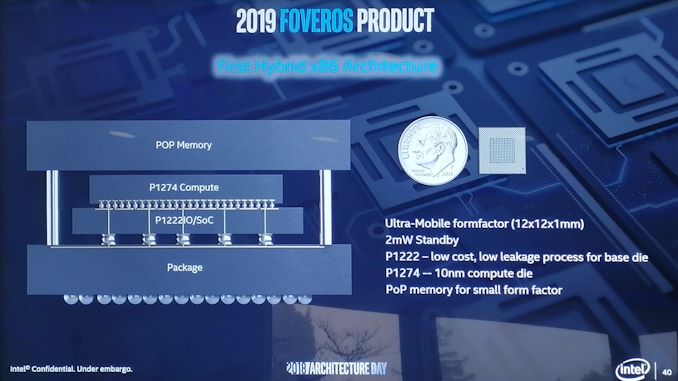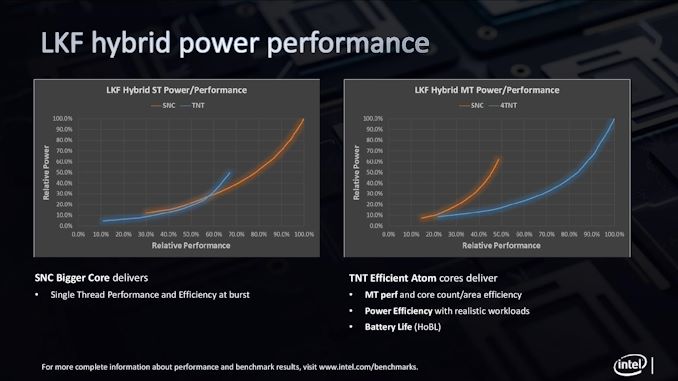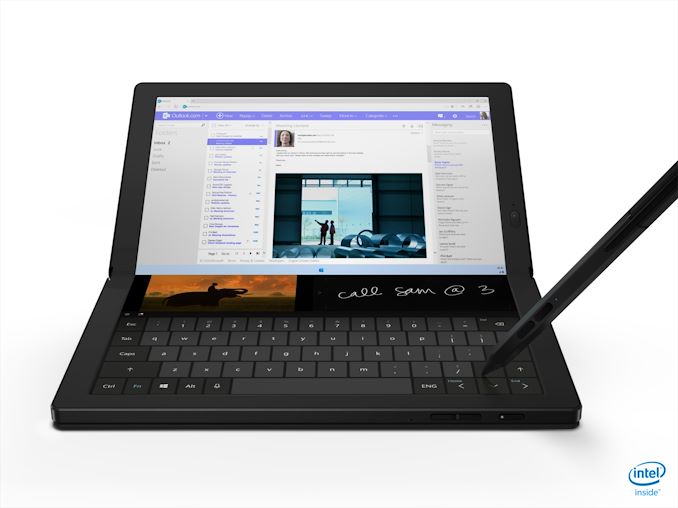Intel Discloses Lakefield CPUs Specifications: 64 Execution Units, up to 3.0 GHz, 7 W
by Dr. Ian Cutress on June 10, 2020 11:00 AM EST
Over the past 12 months, Intel has slowly started to disclose information about its first hybrid x86 platform, Lakefield. This new processor combines one ‘big’ CPU core with four ‘small’ CPU cores, along with a hefty chunk of graphics, with Intel setting out to deliver a new computing form factor. Highlights for this processor include its small footprint, due to new 3D stacking ‘Foveros’ technology, as well as its low standby SoC power, as low as 2.5 mW, which Intel states is 91% lower than previous low power Intel processors. Today’s announcement comes in two parts: first, the specifications.
Intel will debut these two SKUs in its first generation of Lakefield. These CPUs will find homes in premium, always-connected laptops, such as the Samsung Galaxy Book S expected in markets this month, the Lenovo ThinkPad X1 Fold, coming later this year, and in the Microsoft Surface Book Neo.
Both SKUs will feature one big ‘Sunny Cove’ CPU core, along with four little ‘Tremont’ Atom CPU cores. Both sets of cores will have access to a 4 MB last level cache, although Intel has not yet disclosed what sort of cache this is.
Meanwhile on the graphics front, Intel is integrating a Gen11 GPU with 64 execution units, the same number of EUs as on Intel's Ice Lake processors. Interestingly, the iGPU is clocked about half as high as usual for an Intel GPU, with clockspeeds peaking at just 500 MHz – suggesting that Intel is going wide and slow to increase graphics performance. Both CPUs will be rated for a TDP of 7 W.
| Intel Lakefield Processors | ||||||||
| AnandTech | Cores | Base Freq |
1C Turbo |
nT Turbo |
Gen11 IGP |
IGP Freq |
DRAM LP4 |
TDP |
| i5-L16G7 | 1+4 | 1400 | 3000 | 1800 | 64 EUs | 500 | 4267 | 7 W |
| i3-L13G4 | 1+4 | 800 | 2800 | 1300 | 48 EUs | 500 | 4267 | 7 W |
Intel confirmed to us that the base frequency is the unified frequency across all five cores, and the single core turbo frequency applies only to the big Sunny Cove core. Support for LPDDR4X-4266 is a notch above the memory controller in Ice Lake, which only runs at LPDDR4X-3733, and the memory speed will likely be a big boost to performance.
In order to enable these processors in a small 12mm x 12mm footprint, Intel is using its 3D stacking technology, called Foveros. This means that the logic areas of the chip, such as the cores and the graphics, sit on a 10+ nm die, while the IO parts of the chip are on a 22nm silicon die, and they are stacked together. In order to make the connections work, Intel has enabled 50 micron connection pads between the two silicon halves, along with power-focused TSVs (through silicon vias) in order to power the cores on the top layer.
Intel lists the TDP for these chips at 7 W, although the company has not disclosed the turbo power limits for the chip. As mentioned above, Intel hasn’t disclosed how the cache works. In the initial diagrams, we were shown that PoP memory would be added on top, and while Intel hasn't offered further details there, we know from last month's Samsung Galaxy Book S reveal that there will be (at least) 8GB SKUs using LPDDR4X.
We have big questions as to how each of the cores will work, given that by default they support different instruction sets – Intel hasn’t provided information on this at this time. Intel has stated that the scheduling of the threads on the different parts of the CPU will occur based on hardware-guided OS scheduling, although again Intel hasn’t gone into the details of its hardware tracking and enablement on how this is done. In the demos we have seen, Lakefield will use the Tremont cores for almost everything, and only call on the Sunny Cove core for user-experience type of interactions, such as typing or interacting with the screen.
Intel is planning a post-announcement briefing for press to ask questions, which means that this announcement is coming in two parts. This is the information we’re being given beforehand, and we will update you with the details from the post-announcement briefing. As part of this process, we’ve exclaimed to Intel how this way around of presenting details to the press is frustrating – firstly for readers, as you all will have to come back if you want to find out what more Intel tells us later today, but secondly for us, as press, who will have to scramble to jump on the details and decide whether to write fast and miss details, or write slow and miss the wave of traffic.
One thing we can confirm in advance – the Sunny Cove does not appear to be AVX-512 enabled. Intel’s initial press release states that AI workloads occur on the CPU; given the extra power draw required for AVX-512, this is probably a good thing.
More information out of Intel’s post-announcement press-briefing will come later today.














78 Comments
View All Comments
yeeeeman - Wednesday, June 10, 2020 - link
The joke Tremont cores are similar in IPC to Sandy-Ivy Bridge, so 2nd-3rd gen. So for watching videos, editing documents and browsing the web they should more than enough.rrinker - Wednesday, June 10, 2020 - link
Yeah, that's the thing. The various Atom iterations have gotten all kinds of scorn over the years from 'enthusiasts' - well, news flash, they aren't made for those people. I still have an old machine I put together to run my model railroad, it uses one of the first dual core Atoms and I think I splurged and put 4GB on it. No SSD, not back when I built that. Granted, it runs Linux (with GUI, not command line only), but it was more than up for the task.The latest Tremonts blow that thing away. For Mom and Pop to look up recipes, email the grandkids, or post on Facebook about their latest bus trip to the casino, a machine like that is more than powerful enough. They don't need Threadrippers with dual graphics cards. So what if the system with a Tremont only goes up to 8GB RAM, or has no PCIx16,
As an 'enthusiast' - I like to build different types of machines based on their use. Something like this won;t work for a gaming machine, even for the more lightweight games I tend to play. But as a replacement for that old railroad control machine? I bet it would be fine. My primary machine has a discrete GPU for gaming. My workbench system just uses the integrated Intel graphics - it works just fine for electronic drawings, controlling test gear, and programming microcontrollers. My 'server' is the same basic system as my main desktop, less the discrete GPU, in a larger case with more drive bays. 7 of 8 SATA ports are used, plus the system boots from mirrored NVME drives. It's the last system I have with a DVD drive in it.
lmcd - Wednesday, June 10, 2020 - link
The in-between era of PowerVR Atoms were actually the worst though. That's what people are often scarred by.Spunjji - Tuesday, June 16, 2020 - link
@lmcd - you're right about that one. Or the early single-core designs that had to have an Nvidia GPU and chipset welded to them to produce anything like usable performance.PeachNCream - Wednesday, June 10, 2020 - link
I'm an enthusiast and I am perfectly happy with a Bay Trail dual core as my main PC though it is running Linux Mint rather than Windows. When it was on Windows 8.1, it was okay from a performance perspective. I'm not really sure if that would be true on Win10 since I understand that 10 does a lot more Google-like data collection in the background and that might gulp down CPU cycles that would otherwise be put to use doing end user tasks. At any event, not all enthusiasts are interested in high wattage, expensive, and heat intensive hardware. Those kinds of performance or nothing people are usually younger, less practical, and somewhat lacking in wisdom. You can find the same sorts of people running around in loud cars or huge redneck pickup trucks, boasting about performance to an audience of people that are faking interest to be polite to their coworker or family member.ajp_anton - Wednesday, June 10, 2020 - link
How is Tremont a joke? Its IPC is Sandy Bridge level. Sure, clock speeds will be lower, but a Sandy is still OK performance even if seriously underclocked.For iGPU, more is always better. 64EUs at 500MHz is as fast as 32EUs at 1000MHz (because you don't have to worry about parallelization), but draws less power. It's just more expensive, but there you have a reason to have 64EUs.
eddman - Thursday, June 11, 2020 - link
This guy tested a Pentium J5005 (Goldmont Plus) with a Vega 64 and got pretty good results, even with a measly PCIe 2.0 x1.https://rk.edu.pl/en/testing-fanless-pentium-j5005...
Tremont should perform considerably better.
https://nucblog.net/2018/05/gemini-lake-pentium-nu...
Spunjji - Tuesday, June 16, 2020 - link
That's 4 cores with performance equivalent to a ~1.8Ghz Ivy Bridge part. It's certainly not setting the world alight, but I know plenty of people doing standard office work on systems with that kind of power.The GPU core count is high so they can run the cores slower for greater efficiency, while retaining enough performance for displays with high pixel counts. It also gives them more room to salvage imperfect parts. It seems like a sensible trade-off.
stephenbrooks - Wednesday, June 10, 2020 - link
Trying to imagine what natively parallel computer code would do on this. My programs would probably start 5 threads (or 10 with HT) but one of them would finish faster because it's on the Sunny Cove core!lmcd - Wednesday, June 10, 2020 - link
Since Atom cores have rarely (never?) had HT, I think the whole CPU doesn't have HT.